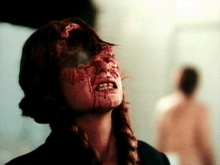Demons, in addition to being a classic of '80s splatter and one of my favorite movies about watching movies in a theater (alongside Tsai Ming-liang's Goodbye Dragon Inn, Bigas Luna's Anguish, and Joe Dante's Matinee; I have a separate canon for favorite movie theater scenes in movies otherwise not taking place in a theater, movies about making movies, movies about projecting movies, movies about watching movies/hanging out at a drive-in, and movies about watching movies on video or TV; Vernon Zimmerman's Fade to Black is a special case that works for most of these categories), is also a collaboration between several major figures in late 20th century Italian horror cinema. It may be easier to name who didn't work on it, but I'll give a brief(??) rundown.
Director Lamberto Bava, son of the legendary horror filmmaker Mario Bava, previously directed Macabre and A Blade in the Dark (reviewed on this site years ago) and followed Demons with You'll Die at Midnight, Delirium, and, of course, Demons 2. Bava's producer was another legendary horror filmmaker, Dario Argento (The Bird with the Crystal Plumage, Deep Red, Suspiria, Tenebre, and the list goes on), and Bava cowrote the screenplay with Argento, Dardano Sacchetti (whose other writing credits include The Cat O' Nine Tails, Twitch of the Death Nerve, Shock, Zombie, Inferno, City of the Living Dead, The Beyond, The House by the Cemetery, 1990: The Bronx Warriors, A Blade in the Dark, and Demons 2), and Franco Ferrini (co-writer of Once Upon a Time in America, Phenomena, Demons 2, Opera, The Church, and Trauma). The music was composed by Claudio Simonetti of Goblin, suppliers of the memorable Suspiria and Dawn of the Dead scores. Simonetti also supplied non-Goblin scores for and/or performed as a musician on multiple Argento films. (Besides Simonetti's music, Demons is jam-packed with synth-pop and metal songs, plus a semi-obscure Rick Springfield tune and Billy Idol's "White Wedding." It should be a mess, but, for Demons, it works.) Bava favorite Gianlorenzo Battaglia handled the stunning cinematography and came back for the sequel (his wildest credit is probably the underwater camera operator on Altman's Popeye).
Did I say this would be brief? The cast includes Nicoletta Elmi, iconic creepy child star of so many '70s Euro-horror cult classics in one of her rare adult roles (she quit acting in the late '80s to become a speech therapist), future Cemetery Man director Michele Soavi, Fiore Argento, daughter of Dario and half-sister of Asia, the striking cult movie legend Geretta Giancarlo aka Geretta Geretta (who shares my birthday along with Harry Dean Stanton, Woody Guthrie, and Ingmar Bergman), Bobby Rhodes, who was brought back for Demons 2 to play a completely different character because he's just that cool, and several actors who aren't horror veterans but look so damn interesting that you'll think you've seen them in other things. I could keep going with the special effects and production design teams, but you have Internet access, so I'll stop here.
Originally intending to make a three-story anthology film, Bava grew so obsessed with Demons that he dropped the other two stories, and I'm so glad he did. There's not much story to Demons, but it's a visual feast of light, shadow, color, neon, architecture, blood, slime, guts, and gore. As beautiful as it is disgusting, Demons never puts something on the screen to move the plot along. Every image is lovingly and carefully framed, photographed, and arranged for maximum visual impact. This is one of those movies that has a mysteriously seductive indefinable atmosphere, a voodoo of location, a palpable presence. It's got that feel. Much like the funk, you can't fake the feel. You've got it or you don't. Demons has it.
Like many great Italian horror movies, Demons doesn't even take place in Italy. The movie opens with college student Cheryl (Natasha Hovey) riding the Berlin U-Bahn to meet up with her friend Kathy (Paola Cozzo). While on the subway platform, Cheryl is followed by a creepy guy with a metal mask covering half his face (Soavi). Her terror dissipates when she realizes Metal Face is handing out free passes to an unnamed movie at the Metropol theater. Bava used the actual Metropol for much of the film, though some interiors were filmed on studio sets in Rome when they really needed to tear shit up and cover shit in goop.
A famous venue in West Berlin that has lived many lives, the Metropol began life as the New Theatre in 1905, a live theater space with a separate concert hall on the top floor. The live theater was turned into a movie theater in 1911, and the concert hall became an operetta in 1914. That top-floor operetta was destroyed in WWII, but the facade and movie theater survived with some repair. The building was renamed the Metropol in 1951, and in 1977, it stopped showing movies and became a disco and live music venue. After the music venue closed in 2000, a porn director turned it into a short-lived sex club called the KitKat Club, someone else turned it into a short-lived upscale nightclub called the Goya in 2005, and yet another owner ran it as a less upscale nightclub until 2014, when the movement of the West Berlin nightlife scene to a different part of the city killed it off. The building rose from the grave in 2019, reopening as the Metropol for live music and events. Besides Demons, the Metropol's other major film appearance was in Wim Wenders' Wings of Desire as the venue where Nick Cave and the Bad Seeds and Crime & The City Solution perform.
Architecture history digression over. Back to the movie. Cheryl convinces Kathy to skip class and go to the Metropol with her. Kathy is kind of whiny about it and hopes it won't be a horror movie but is ultimately convinced. When they arrive, the women are stymied by a Coke machine eating their money, but a couple of young Italian Zack Morris and AC Slater types, George (Urbano Barberini) and Ken (Karl Zinny), save the day. Coke acquired, the women warm up to these chivalrous preppies on the make and don't put up a fuss when the fellas sit next to them. Our other patrons include a no-nonsense pimp named Tony (Rhodes) and two of his stable, Rosemary (Geretta) and Carmen (Fabiola Toledo), a milquetoast young couple, Hannah (Argento) and Tommy (Guido Baldi), hot-tempered middle-aged jerk Frank (Stelio Candelli) and his meek wife Ruth (Nicole Tessier), an insanely cool-looking elderly blind man named Werner (Alex Serra), his caregiver niece Liz (Sally Day), and Liz's secret lover (Claudio Spadaro), and (gestures vaguely) the rest.
Our other important characters are ticket taker and usher Ingrid (Elmi), who also looks insanely cool and retains the mesmerizing screen presence she exhibited as a creepy kid, and a car full of drugged-up street punks who snort cocaine through a straw in a Coke can and break into the theater while on the run from the cops at the worst possible time, causing the demon pandemonium to expand from the theater to the streets. But I'm getting ahead of myself.
The theater lobby, in addition to normal theater lobby items like movie posters, for some reason also contains a motorcycle on a pedestal. Hanging from the bike are a katana and a creepy mask. You know, normal movie theater shit. Rosemary is a sassy party type who plays by her own rules (she smokes in the theater even after Ingrid tells her to put out her cigarette), so she immediately picks up the mask and puts it on, though a sharp edge cuts her on the cheek after she takes it off.
Everyone takes their seats and the movie begins. Oh shit, Kathy. It's a horror movie. The film-within-the-film (directed by Soavi) is a competent bit of young people exploring ancient graves biz that looks decent enough to keep the crowd's attention but isn't good enough to steal any thunder from the actual movie called Demons that we are currently watching. When a character finds a creepy mask that looks just like the mask in the lobby, puts it on, and cuts his face in the same spot as Rosemary, Rosemary and Carmen get a little wigged out. The no-nonsense Tony has no time for this nonsense and tells them so. When Rosemary's cheek starts bleeding again, she heads to the bathroom to wash it off and apply some pressure, but of course she turns into a damn demon and our demon pandemonium begins.
The rest of the movie is a battle to the death between theatergoers and demons. It's exciting, violent, splattery as hell, visually thrilling, and logically incoherent. I'm a lover of movies that eschew the conventions and rules of logical storytelling and everyday life, and I almost always prefer the part of the movie where we don't yet have an explanation to the part of the movie that gives us the explanation. Demons never explains. We never find out why the demons exist, what their end goal is, why they picked the theater, who booked the movie, why that guy has a part-metal face (or even who the hell he is), why Ingrid seemed to be in on the conspiracy until she didn't, (BRIEF SPOILER) why a damn helicopter falls through the roof (END OF SPOILER), or how any of this came into being. I love that. Some people find that a weakness. I find it a strength. Each movie make its own rules. There are plenty of movies that make logical narrative sense. We also need some that don't. It makes the world go round, baby. It's real freedom.
I love this movie. I love it so much. (I also like the sequel, though I miss the movie theater setting, but I'll get into that in a later post.) It's dark and funny and beautiful and intense and goofy and brutal and a lovely tribute to the theatrical experience and a great place to point your eyeballs. Yeah, the storytelling's a little thin, but this is a movie about the creation of images. Too much storytelling only gets in the way.























